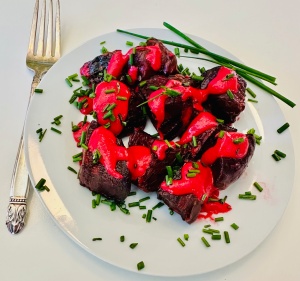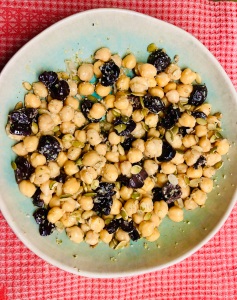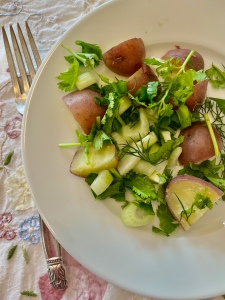Instead of a shank bone, many people now replace it with a roasted beet on their seder plate (z’roa) as a representation of the pascal lamb, for a veg based meal. Inspired by this custom, I decided to prepare a roasted beet dish. I used red beets but you could use golden or an assortment. I love the versatility of beets-raw, roasted, liquified, and more. This one is a combination of roasted beets as well as tahini with roasted beets. Added bonus are the chives I clipped from my sister’s garden to sprinkle on top. Scroll below for the recipe plus my other previous Pesach recipes including karpras salad and olive oil chocolate cake. And, click here to learn about leaving an empty seat at your seder table for a hostage. Continue reading
Category Archives: Salad
Purim: Queen Esther’s Salad
You might be wondering where the hamantaschen recipe is (scroll to the bottom) or why I’m sharing a bean recipe for Purim. The Queen Esther salad that I created is for a Purim seudah (meal) and is made with many symbolic ingredients. First, according to Gil Marks in Olives and Honey Trees, chickpeas are a traditional Ashkenazi food eaten at Purim (amongst other celebrations). Olives are a symbol of mourning and also commonly eaten in Purim dishes that symbolized Haman (along with eggs and other ingredients like noodles), as explained in Claudia Roden’s, The Book of Jewish Food. Last, there’s a Talmudic teaching that Queen Esther became a vegan, eating just legumes and seeds while she lived in King Achashaverus palace, to ensure she did not eat non kosher foods (another bonus of being vegan :)). I generally sprinkle seeds on my salad, because I like the crunchy texture and contrasting flavors they provide. And, if you’re looking for more delicious (and sweet) Purim recipes, they are at the bottom of the post (including two types of hamantaschen)! Continue reading
Passover: Karpas Salad
This is a really easy, yummy salad filled with lots of karpas or related ingredients. The karpas course of the seder includes a vegetable (often parsley or potatoes) that is symbolic of spring and then dipped in salt water, representative of the Israelites tears. This salad can be served. If you eat light foods during your seder before the main meal, this is an easy addition to the meal that can be quickly prepared. Also, scroll down for my other Passover recipes including sweets and savory dishes. Continue reading
Salad at Hummus Yossef
I don’t have the guts to declare one place with the best hummus. I will decidedly write, though, that I eat a lot of hummus, and taste test it the way some do with wines, (albeit a lot cheaper). And, I will argue that Hummus Yossef, from Pardes Hanna Karkur–and now with some locations in Tel Aviv–has some of the best hummus I have ever eaten. It is made fresh for each customer (check out their Cuisinart blenders whirring by the cash register) At its modest first shop—with an outdoor seating area that protected us from the searing sun with intensely blowing fans and a tarp roof –a bowl of Galilee-style hummus was presented to us. It is creamy, very lemony hummus, and heavy enough to seemingly cut it with a knife. Presented in a deep, nearly overflowing bowl, the hummus is immersed in a thorough amount of fruity olive oil, while flecked with whole chickpeas, drizzled with green delightful spicy schug, pillowy drops of tahini, and sprinkled with freshly chopped parsley. The hummus decidedly strong flavors were enhanced by the perfect balance of spicy, mild and fruity liquid toppings. It made a regular “plain” bowl of hummus seem almost bland or naked in comparison. Continue reading
Kislev: Rainbows, Oil and Salt
During the month of Kislev, which begins later this week, we celebrate Chanukah. The most obvious food of this holiday and month is oil, the miracle ingredient. During Chanukah, some women recite the story of Judith, a heroine who used salt as a weapon. “Legend has it that Judith fed the enemy general Holofernes salty foods to make him thirsty for wine. As he lay in a drunken stupor she was able to slay him, thus saving Jerusalem from siege.”
A symbol of Kislev is keshet (rainbow). During Kislev, when the flood waters receded, a rainbow appeared in the sky and God told Noah, “I will keep my covenant with you and your descendants…and never again will a flood destroy all life. . . . I have put my rainbow in the clouds, and it will be the sign of the covenant between Myself and the world. “
Vaera: Slavery Now
In Vaera, we read that Pharoah digs in his heels, hardens his heart and refuses to liberate the Israelite slaves, thus launching plagues against the Egyptians. “Even from such hardened sinners as Pharaoh and the Egyptians, God did not withhold the opportunity of mending their ways. Before a plague visited them Moses was charged to warn them of its coming, to-morrow, if they remained obdurate.” (Exodus Rabba)
So, why does Pharoah continue to enslave the Israelites?
Commentary in Etz Hayyim notes that the Israelites “must be freed in such a way that they, the Egyptians, and all the nations of the world will understand that it was God’s doing, not Pharaoh’s goodwill” (p. 351). The Israelites understanding of God’s role in their liberation is important “to establish the principle that it is unacceptable for one human being to reduce another human being to slavery, that freedom is the will of God and not the choice of a despot” (p. 351). This story’s universal message is important today.







